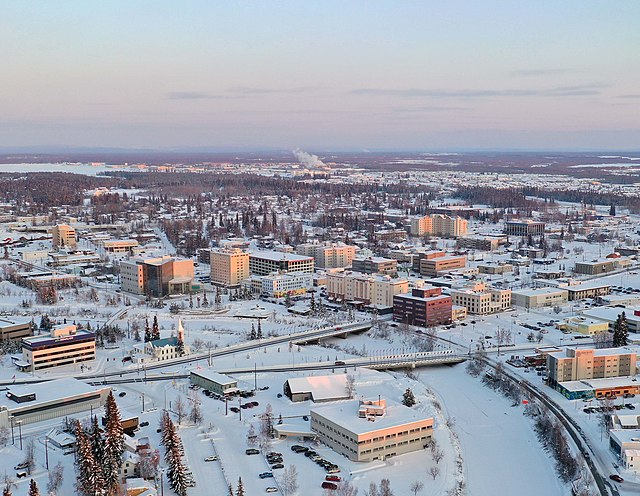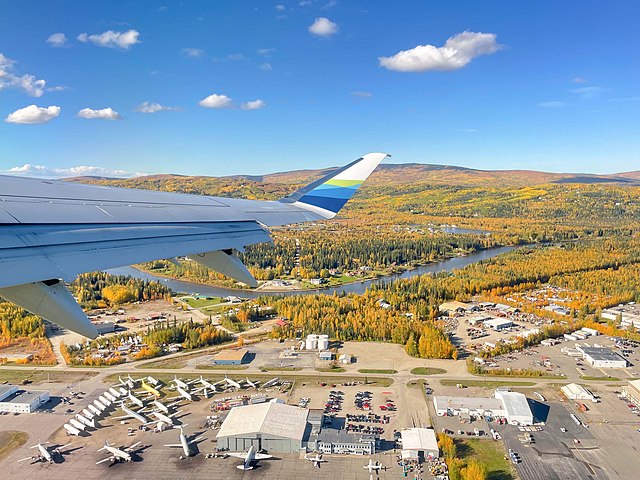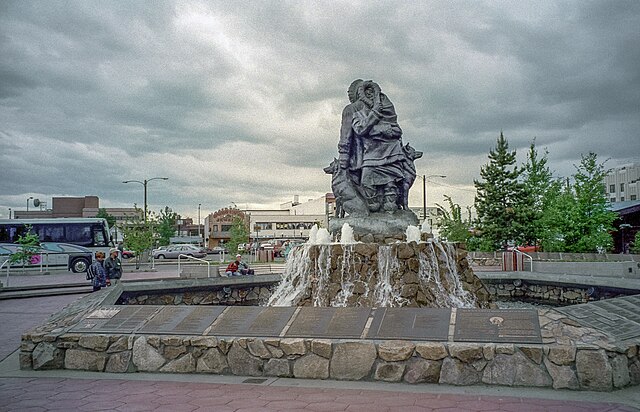Understanding Fairbanks’ Unique Geographic Location
Fairbanks sits in the heart of Alaska’s interior, about 358 miles north of Anchorage and just 120 miles south of the Arctic Circle. This strategic location places the city in what meteorologists call a continental subarctic climate zone, creating some of the most dramatic weather patterns you’ll find anywhere in North America.
The city’s position in the Tanana Valley, surrounded by hills and mountains, creates a unique microclimate that significantly influences local weather patterns. Unlike coastal Alaskan cities that benefit from moderating ocean currents, Fairbanks experiences the full brunt of continental weather systems without any maritime influence to soften the extremes.
At 64.8° North latitude, Fairbanks is far enough north to experience dramatic seasonal variations in daylight hours, which directly impacts temperature patterns and weather phenomena throughout the year. The city’s elevation of approximately 436 feet above sea level also plays a role in its climate characteristics.
The Four Distinct Seasons of Fairbanks
Fairbanks experiences four very distinct seasons, each with its own unique weather personality. Unlike many places where seasons blend gradually into one another, Fairbanks weather can shift dramatically, almost like someone flipping a switch between seasonal modes.
The transition periods between seasons are often brief but spectacular, with rapid changes in temperature, daylight hours, and atmospheric conditions. These transitions create some of the most memorable weather experiences you’ll encounter in Interior Alaska.
Winter Weather in Fairbanks (October to March)
Winter in Fairbanks isn’t just cold – it’s a masterclass in extreme weather that can humble even the most experienced cold-weather veterans. The winter season typically begins in earnest by late October and doesn’t loosen its grip until March, creating nearly six months of serious cold weather.
Average winter temperatures hover around -10°F to -20°F, but these numbers don’t tell the whole story. The real character of Fairbanks winter lies in its ability to surprise you with temperature swings that can range from a relatively balmy 20°F to bone-chilling -50°F within the same week.
December through February represents the heart of winter, when the sun barely peeks above the horizon for a few hours each day. During the winter solstice, Fairbanks receives less than four hours of daylight, creating a twilight world that profoundly affects both weather patterns and human psychology.
Extreme Cold: When Temperatures Drop Below -40°F
When Fairbanks temperatures plunge below -40°F, the city enters what locals call “real winter.” At these temperatures, the very air seems to take on a different quality – it becomes sharp, crystalline, and almost tangible as you breathe.
These extreme cold snaps typically occur during clear, calm nights when radiational cooling allows temperatures to plummet without interference from clouds or wind. The record low temperature in Fairbanks reached -66°F in 1934, a reminder of just how extreme Interior Alaska weather can become.
During these cold snaps, everyday activities require careful planning and preparation. Car engines need block heaters to start, exposed skin can freeze in minutes, and even indoor activities become affected as heating systems work overtime to maintain comfortable temperatures.
Ice Fog: Fairbanks’ Mysterious Winter Phenomenon
One of Fairbanks’ most distinctive winter weather phenomena is ice fog – a surreal atmospheric condition that occurs when temperatures drop below -20°F and humidity sources create suspended ice crystals in the air.
Ice fog typically develops when warm, moist air from sources like car exhausts, building heating systems, or even human breath meets the extremely cold air. The result is a ghostly fog composed of tiny ice crystals that can reduce visibility to mere feet and create an otherworldly atmosphere throughout the city.
This phenomenon is most common during temperature inversions, when cold air becomes trapped in the Tanana Valley. The fog can persist for days, creating driving hazards and giving Fairbanks an almost mystical appearance during the darkest months of winter.
Spring Weather Patterns (April to May)

Spring in Fairbanks is perhaps the most dramatic seasonal transition you’ll experience anywhere. After months of deep cold and minimal daylight, the city awakens with remarkable speed as temperatures rise and daylight hours increase rapidly.
April marks the beginning of breakup season, when winter’s grip finally starts to loosen. Temperatures begin climbing above freezing during the day, though nights can still dip well below zero. This creates a fascinating daily cycle of freezing and thawing that transforms the landscape.
May brings more consistent warming, with average temperatures climbing into the 50s and 60s°F. The rapid increase in daylight hours – gaining about six minutes per day – creates an almost manic energy as both nature and residents emerge from winter’s hibernation.
The spring melt creates unique weather challenges, including flooding potential from ice jams on the Chena River and muddy conditions as the frozen ground slowly thaws. Despite these challenges, spring represents hope and renewal after the long winter months.
Summer Climate in Fairbanks (June to August)
Summer weather in Fairbanks comes as a delightful surprise to many visitors expecting perpetual cold. From June through August, temperatures regularly climb into the 70s and 80s°F, with occasional spikes into the 90s during heat waves.
July typically represents the warmest month, with average high temperatures around 72°F. However, Fairbanks summers are characterized by significant daily temperature variations – it’s not uncommon to experience a 40-degree difference between daytime highs and nighttime lows.
The summer season brings long, warm days perfect for outdoor activities, gardening, and exploring Interior Alaska’s natural beauty. Thunderstorms occasionally develop during the warmest afternoons, providing dramatic sky displays and welcome precipitation for the region’s forests and gardens.
The Midnight Sun Effect on Weather
During peak summer, Fairbanks experiences nearly 22 hours of daylight around the summer solstice, creating the famous midnight sun phenomenon. This extended daylight has profound effects on local weather patterns and daily temperature cycles.
The continuous solar input prevents significant nighttime cooling, leading to consistently warm temperatures that can feel almost tropical compared to winter conditions. Gardens and vegetation respond dramatically to this extended growing season, with some plants achieving remarkable growth rates.
The midnight sun also affects local weather patterns by reducing temperature inversions and creating more consistent air mixing throughout the day. This leads to generally clearer skies and more stable atmospheric conditions during the height of summer.
Fall Weather Transitions (September)
Fall in Fairbanks is brief but spectacular, compressed into essentially the month of September. This rapid transition from summer warmth to winter cold creates some of the most beautiful and volatile weather conditions of the year.
September temperatures typically range from highs in the 60s early in the month to highs in the 40s by month’s end. Nighttime temperatures begin dipping below freezing, creating frost warnings and the first hints of winter’s approach.
The rapid decrease in daylight hours – losing about six minutes per day – creates dramatic changes in daily weather patterns. Morning frost becomes common, while afternoons may still warm into comfortable temperatures for outdoor activities.
Annual Temperature Averages and Records
Understanding Fairbanks’ temperature patterns requires looking beyond simple averages to appreciate the full range of weather extremes this city experiences. The annual average temperature hovers around 26°F, but this number masks the incredible 150+ degree range between record highs and lows.
The warmest temperature ever recorded in Fairbanks reached 96°F in July 1919, while the coldest plunged to -66°F in December 1934. This 162-degree range represents one of the largest temperature ranges experienced by any major city in North America.
Monthly average temperatures tell the story of Fairbanks’ extreme seasonality: January averages -10°F, while July averages 62°F. This 72-degree difference between winter and summer averages illustrates the continental climate’s dramatic seasonal swings.
Daily temperature variations can also be extreme, particularly during transitional seasons. Spring and fall regularly experience 40-50 degree daily temperature ranges, creating weather conditions that require flexible clothing strategies and constant awareness of changing conditions.
Precipitation Patterns Throughout the Year

Fairbanks receives relatively modest precipitation compared to coastal Alaska, averaging about 11 inches of annual rainfall and 65 inches of snowfall. However, the distribution of this precipitation creates distinct wet and dry seasons that significantly impact local weather patterns.
The precipitation pattern follows a continental model, with most moisture arriving during summer months when atmospheric circulation patterns favor storm development. Winter precipitation is limited, creating the dry, cold conditions that allow for extreme temperature drops.
Snowfall Statistics and Snow Season Length
Snow season in Fairbanks typically begins in early October and extends through April, creating approximately seven months of snow cover. The average annual snowfall of 65 inches might seem modest compared to some regions, but the cold temperatures ensure snow accumulates and persists throughout winter.
The snowpack typically builds steadily through December and January, reaching maximum depths of 12-18 inches by late winter. However, the dry nature of Interior Alaska snow means it’s often light and powdery, creating excellent conditions for winter sports but also contributing to wind-blown snow events.
Snow quality varies significantly throughout the season. Early and late season snow often experiences melt-freeze cycles that can create icy conditions, while mid-winter snow remains consistently dry and powdery due to sustained cold temperatures.
Rainfall Distribution and Dry Periods
Summer rainfall in Fairbanks follows an interesting pattern, with June through August receiving the majority of annual precipitation. July typically represents the wettest month, averaging about 2 inches of rainfall.
Thunderstorms provide much of the summer precipitation, often developing during warm afternoons when atmospheric instability peaks. These storms can be intense but brief, occasionally producing small hail and spectacular lightning displays.
Extended dry periods are common, particularly during late winter and early spring when snow cover prevents soil moisture evaporation and atmospheric moisture remains low. These dry conditions contribute to forest fire risk during summer months when temperatures rise and vegetation dries out.
Weather Phenomena Unique to Fairbanks
Fairbanks’ geographic location and climatic conditions create several weather phenomena that are rare or impossible to experience elsewhere. These unique conditions contribute to the city’s reputation as one of North America’s most interesting weather destinations.
The combination of extreme cold, latitude, and continental location creates perfect conditions for phenomena like diamond dust, sun dogs, and atmospheric halos that occur regularly during winter months. These optical phenomena turn even the coldest days into spectacular displays of natural beauty.
Aurora Borealis and Weather Conditions
Fairbanks sits directly beneath the aurora oval, making it one of the world’s premier destinations for viewing the Northern Lights. The aurora season typically runs from late August through early April, coinciding with the period of sufficient darkness for viewing.
Clear, cold nights provide the best aurora viewing conditions, when atmospheric stability reduces light pollution and allows the aurora’s colors to shine brilliantly against the dark sky. Temperature inversions, while creating ice fog in the city, often produce crystal-clear skies in surrounding areas perfect for aurora photography.
The aurora’s appearance often correlates with specific weather patterns. High-pressure systems that bring clear skies and calm winds create ideal viewing conditions, while storm systems and cloudy weather obscure the lights even when geomagnetic activity is high.
Temperature Inversions in the Tanana Valley
Temperature inversions occur frequently in Fairbanks due to the city’s location in the Tanana Valley. During these events, warm air sits above cold air trapped in the valley, creating stable atmospheric conditions that can persist for days or weeks.
These inversions contribute to several unique weather phenomena, including the persistence of ice fog, the concentration of air pollutants, and dramatic temperature differences between the valley floor and surrounding hills. It’s not uncommon for temperatures to be 20-30 degrees warmer just a few hundred feet above the city.
Understanding inversions is crucial for both residents and visitors, as they significantly affect air quality, visibility, and outdoor activity planning. During strong inversions, driving to higher elevations can literally transport you from cold, foggy conditions to warm, sunny weather within minutes.
How Climate Change is Affecting Fairbanks Weather

Climate change impacts are particularly pronounced in Interior Alaska, with Fairbanks experiencing warming trends that exceed global averages. These changes are reshaping traditional weather patterns and creating new challenges for residents and ecosystems.
Winter temperatures have shown the most dramatic changes, with average winter temperatures rising approximately 6°F over the past 50 years. This warming has shortened the extreme cold season and reduced the frequency of temperatures below -40°F.
The warming trend affects precipitation patterns, with increasing winter precipitation falling as rain rather than snow. This creates challenging conditions including ice storms, flooding potential, and unstable snow conditions that affect transportation and outdoor activities.
Summer weather patterns are also shifting, with longer, warmer seasons contributing to increased wildfire risk and changes in vegetation patterns. These changes create feedback loops that further modify local weather conditions and ecosystem dynamics.
Best Times to Visit Fairbanks Based on Weather
Choosing the best time to visit Fairbanks depends entirely on what weather experiences you’re seeking and what activities you plan to enjoy. Each season offers unique weather-related attractions and challenges that appeal to different types of visitors.
For aurora viewing, the period from late September through March offers the best combination of darkness and clear weather potential. However, visitors must be prepared for extreme cold and limited daylight during peak aurora season.
Summer visitors (June through August) experience the most comfortable weather conditions, with warm temperatures, long daylight hours, and minimal precipitation. This season is ideal for outdoor activities, wildlife viewing, and exploring Interior Alaska’s natural attractions without extreme weather concerns.
Spring and fall offer shoulder season opportunities with unique weather phenomena, fewer crowds, and dramatic seasonal transitions. However, these periods can be unpredictable, with rapid weather changes requiring flexible planning and appropriate gear for varying conditions.
Weather Preparedness Tips for Fairbanks Residents and Visitors
Successfully living with or visiting Fairbanks weather requires understanding, preparation, and respect for the power of Interior Alaska’s climate extremes. Proper preparation can transform potentially dangerous weather into memorable experiences.
Layered clothing systems work best for Fairbanks weather, allowing you to adjust your insulation as conditions change throughout the day. Quality outer layers that block wind and moisture are essential, as are insulated boots rated for extreme cold conditions.
Vehicle preparation becomes critical during winter months, with engine block heaters, emergency supplies, and winter tires being essential rather than optional equipment. Understanding how to operate vehicles in extreme cold and what to do if stranded can literally be life-saving knowledge.
Indoor preparation involves understanding heating systems, having backup heating sources, and maintaining emergency supplies for extended power outages. Weather monitoring becomes a daily habit, as conditions can change rapidly and dramatically affect travel and outdoor activity safety.
Conclusion
Fairbanks weather represents one of North America’s most extreme and fascinating climate experiences, where temperatures can span more than 150 degrees throughout the year and where natural phenomena create displays that exist nowhere else on Earth. From bone-chilling winters that test human endurance to surprisingly warm summers under the midnight sun, Fairbanks offers weather experiences that challenge assumptions and create lifelong memories.
Understanding these weather patterns isn’t just academic – it’s essential for anyone living in or visiting Interior Alaska. The extreme seasonal variations, unique phenomena like ice fog and aurora displays, and the ongoing impacts of climate change all combine to create a weather environment that demands respect, preparation, and appreciation.
Whether you’re drawn by the romance of aurora-lit winter nights or the endless summer days perfect for outdoor adventures, Fairbanks weather will surprise, challenge, and ultimately reward those who take the time to understand and prepare for its extremes. The city’s climate may be harsh, but it’s also one of the most characterful and memorable weather experiences you’ll find anywhere in the world.
Frequently Asked Questions
1. What is the coldest temperature ever recorded in Fairbanks, Alaska?
The coldest temperature ever officially recorded in Fairbanks was -66°F (-54°C) on December 27, 1934. However, many unofficial readings have recorded even lower temperatures during extreme cold snaps, and some areas around Fairbanks have experienced temperatures approaching -70°F during the most severe Arctic outbreaks.
2. How many hours of daylight does Fairbanks get during winter and summer?
During the winter solstice (around December 21), Fairbanks receives less than 4 hours of daylight, with the sun barely rising above the horizon. In contrast, during the summer solstice (around June 21), the city experiences nearly 22 hours of daylight, with the sun setting briefly but never creating true darkness – this is the famous “midnight sun” phenomenon.
3. When is the best time to see the Northern Lights in Fairbanks?
The aurora season in Fairbanks runs from late August through early April, but the peak viewing months are typically September through March. The best conditions occur on clear, cold nights with little to no moon interference. Late fall through early spring offers the optimal combination of darkness and clear weather for aurora viewing.
4. How much snow does Fairbanks get annually?
Fairbanks averages approximately 65 inches of snowfall per year, which is relatively modest compared to many northern cities. However, the extremely cold temperatures mean that snow accumulates and persists throughout the winter months, typically from October through April, creating a reliable snow cover for winter activities.
5. Is it true that cars won’t start in extreme Fairbanks cold?
Yes, extreme cold can prevent vehicles from starting without proper preparation. At temperatures below -20°F, engine oil thickens significantly, batteries lose capacity, and fuel can gel. Most Fairbanks residents use engine block heaters, battery warmers, and synthetic oils to ensure their vehicles start reliably. Many parking areas provide electrical outlets specifically for plugging in these heating systems during winter months.

